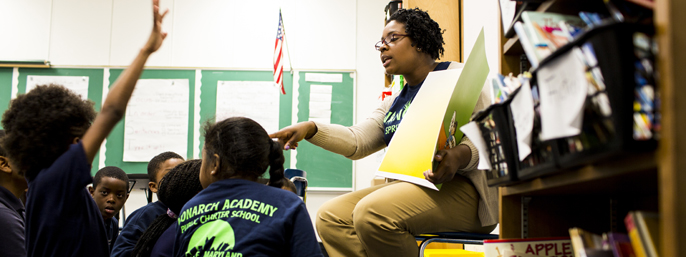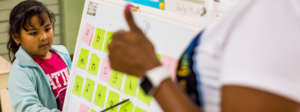There are a few big obstacles to excellence and equity in our P-12 landscape that we accept for no good reason. One of the biggest is the shortage of Black, Latinx, Asian, and Indigenous educators in our schools. There’s simply no good explanation for our decades-long inability to bring abundant talent in our communities of color into public school classrooms. Research shows how much of a difference it could make for all students, but especially for students of color: Students with same race as their teacher are more likely to complete high school and go to college, less likely to be suspended, and more likely to be referred to gifted and talented programs. Yet across the country, while more than half of students in the United States identify as people of color, 80 percent of teachers are white.
It’s a complex problem with many causes, from certification rules that prioritize test scores over teaching ability, to latent bias in district recruitment and hiring processes, to school cultures that too often fail to help teachers of color build long careers in the classroom. But one institution has largely escaped scrutiny in this conversation: teacher preparation programs. These programs train our current and future teaching workforce, and effectively decide what it will look like. If they don’t train enough teachers of color, school systems won’t have enough to hire. And right now, they produce teachers who are overwhelmingly white. In other words, the teacher diversity gap will persist until we close the teacher prep diversity gap.
Today, we’re proud to release A Broken Pipeline: Teacher Preparation’s Diversity Problem, an analysis that shines a light on this underappreciated piece of the teacher diversity challenge.
Using data from the U.S. Department of Education, we compared the demographics of teacher preparation program enrollees to that of public school students to calculate each state’s teacher prep diversity gap—allowing us to see the scope of the problem at the state level and identify national and regional trends. We also highlight individual teacher preparation programs that are—and are not—recruiting enough prospective teachers of color to match student demographics in their states. Our findings include:
- Teacher preparation programs are significantly whiter, on average, than the public school population. In the 50 states and Washington, D.C., enrollees at teacher preparation programs are nearly 64% white, while public school students are 47% white.
- Teacher prep diversity gaps exist in almost every state. Out of the 50 states and Washington, D.C. , 48 have higher percentages of white teacher preparation program enrollees than white public school students. And the gaps are large in most states: 43 states have a gap that’s at least 10 percentage points.
- A significant percentage of programs—serving a significant number of future teachers—are more than 90 percent white. Out of the programs that had enrollees in 2017-18, 455 are more than 90% white. They have 52,195 enrollees—11.4% of total teacher preparation enrollment. Many of these programs are large—in fact, there are 35 programs with enrollment of 400 or more that are at least 90% white.
- Alternative certification programs are significantly more diverse than traditional programs. Traditional programs are 69.6% white, while alternative certification programs are only 46.8% white. While differences in location, size, and other factors between alternative and traditional programs likely explain part of the gap, the data suggest that creating alternative pathways can be a useful tool for states interested in producing more teachers of color.
We also provide a series of recommendations for programs, districts, and state governments. The teacher prep diversity gap is a complex but eminently fixable problem, even in the short-term, as we’ve seen in our own programs.
We’re in no way suggesting that teacher preparation programs are solely responsible for the shortage of teachers of color. But to address this problem, all parties involved—from the state and federal government, to teacher preparation programs, to districts—need to commit to and be held accountable for doing better. We hope this paper can help start conversations across the country on an important topic, and hopefully encourage education leaders to make diversifying the teaching profession a top priority.








